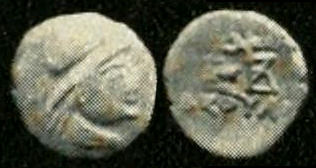Liaka Kusuluka on:
[Wikipedia]
[Google]
[Amazon]
 Liaka Kusulaka (
Liaka Kusulaka (
Dates for Kanishka and the Indo-Scythians
{{Indo-Scythians Indo-Scythian satraps 1st-century BC Iranian monarchs 1st-century BC Iranian people
 Liaka Kusulaka (
Liaka Kusulaka (Greek
Greek may refer to:
Greece
Anything of, from, or related to Greece, a country in Southern Europe:
*Greeks, an ethnic group.
*Greek language, a branch of the Indo-European language family.
**Proto-Greek language, the assumed last common ancestor ...
: , on his coins; Prakrit
The Prakrits (; sa, prākṛta; psu, 𑀧𑀸𑀉𑀤, ; pka, ) are a group of vernacular Middle Indo-Aryan languages that were used in the Indian subcontinent from around the 3rd century BCE to the 8th century CE. The term Prakrit is usu ...
: Liaka Kusulaka or , , on the Taxila copper plate
The Taxila copper-plate, also called the Moga inscription or the Patika copper-plate is a notable archaeological artifact found in the area of Taxila, Gandhara, in modern Pakistan. It is now in the collection of the British Museum.
Description
...
) was an Indo-Scythian
Indo-Scythians (also called Indo-Sakas) were a group of nomadic Iranian peoples of Scythian origin who migrated from Central Asia southward into modern day Pakistan and Northwestern India from the middle of the 2nd century BCE to the 4th centur ...
satrap of the area of Chukhsa
Chukhsa was an ancient area of Pakistan, probably modern Chach, west of the city of Taxila.
History
The area is mentioned in various epigraphic material, such as the Taxila copper plate inscription, where it is described as a territory of ...
in the northwestern South Asia
South Asia is the southern subregion of Asia, which is defined in both geographical
Geography (from Greek: , ''geographia''. Combination of Greek words ‘Geo’ (The Earth) and ‘Graphien’ (to describe), literally "earth descr ...
during the 1st century BCE.
Name
Liaka Kusulaka name is recorded on his coins in theGreek
Greek may refer to:
Greece
Anything of, from, or related to Greece, a country in Southern Europe:
*Greeks, an ethnic group.
*Greek language, a branch of the Indo-European language family.
**Proto-Greek language, the assumed last common ancestor ...
form (), and on the Taxila copper plate
The Taxila copper-plate, also called the Moga inscription or the Patika copper-plate is a notable archaeological artifact found in the area of Taxila, Gandhara, in modern Pakistan. It is now in the collection of the British Museum.
Description
...
in the Kharosthi form (). The name is composed od from Saka
The Saka ( Old Persian: ; Kharoṣṭhī: ; Ancient Egyptian: , ; , old , mod. , ), Shaka (Sanskrit ( Brāhmī): , , ; Sanskrit (Devanāgarī): , ), or Sacae (Ancient Greek: ; Latin: ) were a group of nomadic Iranian peoples who hist ...
, meaning "youth" and "striving, ambitious, energetic".
Reign
He is mentioned in theTaxila copper plate
The Taxila copper-plate, also called the Moga inscription or the Patika copper-plate is a notable archaeological artifact found in the area of Taxila, Gandhara, in modern Pakistan. It is now in the collection of the British Museum.
Description
...
inscription (Konow 1929: 23-29), dated between 90 and 6 BCE, as the father of Patika Kusulaka, and is characterized as a "kshaharata" (also the name of the first dynasty of the Western Satraps
The Western Satraps, or Western Kshatrapas (Brahmi:, ''Mahakṣatrapa'', "Great Satraps") were Indo-Scythian (Saka) rulers of the western and central part of India ( Saurashtra and Malwa: modern Gujarat, Maharashtra, Rajasthan and Madhya Pradesh ...
) and as kshatrapa of Chukhsa.
He minted coins which are direct imitations of the coins of Eucratides (King's head and Dioscuri
Castor; grc, Κάστωρ, Kástōr, beaver. and Pollux. (or Polydeukes). are twin half-brothers in Greek and Roman mythology, known together as the Dioscuri.; grc, Διόσκουροι, Dióskouroi, sons of Zeus, links=no, from ''Dîos'' ( ...
), with his name inscribed "ΛΙΑΚΟ ΚΟΖΟΥΛΟ".
The name "Κοζουλο" was also used by the first Kushan ruler Kujula Kadphises
Kujula Kadphises (Kushan language: Κοζουλου Καδφιζου, also Κοζολα Καδαφες; Kharosthi: 𐨐𐨂𐨗𐨂𐨫 𐨐𐨯, IAST: ', '; Ancient Chinese: 丘就卻, ''Qiujiuque''; reigned 30–80 CE, or 40-90 CE according to B ...
(Greek: Κοζουλου Καδφιζου, ''Kozoulou Kadphizou'' or Κοζολα Καδαφες, ''Kozola Kadaphes''), which may suggest some family connection.
Notes
External links
Dates for Kanishka and the Indo-Scythians
{{Indo-Scythians Indo-Scythian satraps 1st-century BC Iranian monarchs 1st-century BC Iranian people